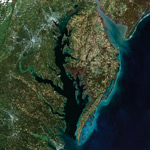
2022 surveys of juvenile striped bass in the Chesapeake Bay watershed yielded mixed results. Conducted by biologists in Maryland and Virginia, the surveys included counts of juvenile striped bass and other species in waters of the Chesapeake Bay.
Maryland Striped Bass Survey
The 2022 Maryland Department of Natural Resources (DNR) juvenile striped bass survey young-of-year index is 3.6, which is slightly higher than last year’s result, but remains below the long-term average of 11.3.
DNR biologists captured more than 40,000 fish of 58 different species during the 3-month survey. One positive result was the increased abundance of spot, a popular species used for food and bait. Spot abundance was the highest observed in over a decade.
The DNR survey is conducted at 22 sites located in four major spawning areas: the Choptank, Nanticoke, and Potomac rivers, and the upper Chesapeake Bay. Biologists visit each site three times per summer, collecting fish with two sweeps of a 100-foot beach seine net. The index represents the average number of recently hatched striped bass captured in each sample.
Virginia Striped Bass Survey
Preliminary results from an ongoing long-term survey conducted by researchers at the Virginia Institute of Marine Science suggest another average year class of young-of-year striped bass was produced in Virginia tributaries of the Chesapeake Bay in 2022. The 2022 year class represents the group of fish hatched this spring that will grow to fishable sizes in three to four years.
The VIMS Juvenile Striped Bass Seine Survey recorded a mean value of 7.95 fish per seine haul in the Virginia portion of the Chesapeake Bay; this value is called a recruitment index by scientists. The 2022 value is similar to the historic average of 7.77 fish per seine haul and represents the 10th consecutive year of average or above-average recruitment in Virginia waters.
Although there can be considerable variation in striped bass recruitment among years, the indices observed in recent years suggest that abundance of juvenile striped bass in Virginia has been relatively stable.
The VIMS survey samples 18 index sites in the Rappahannock, York, and James River watersheds. Biologists sample each site 5 times from mid-June to mid-August, deploying a 100-foot seine net from the shore. Each fish captured in the net is counted, measured, and returned to the river.
Young-of-the-year striped bass usually measure between 1.5 and 4 inches. Survey scientists in Virginia measured 2,236 juvenile striped bass at these stations in 2022. VIMS has been conducting the survey annually since 1967 for the Virginia Marine Resources Commission (VMRC).
Differences between Maryland and Virginia indices are not uncommon. For example, in 2013, 2016, 2019, 2020, and 2021 MDNR recorded below-average year classes in Maryland, while VIMS recorded average or above-average year classes in Virginia. The causes of such differences vary annually and can be difficult to determine. Striped bass populations, however, are supported by strong year classes which can mitigate the impact of less productive years.
Striped bass play an important role as a top predator in the Chesapeake Bay ecosystem and are a valuable resource for commercial and recreational anglers.
The striped bass population in Chesapeake Bay has rebounded from historic lows in the late 1970s and early 1980s after fishing bans were enacted in Delaware, Maryland, and Virginia in the mid- to late-1980s. Since then, the population increased to the point that striped bass in the Bay and elsewhere were considered recovered.
In 2019, scientists determined that the striped bass population was overfished and that mortality due to fishing was higher than what the population can withstand in the long term. Monitoring of juvenile striped bass recruitment will continue next year to provide managers with crucial information to sustainably manage this important species.
Atlantic Coast states enacted responsible conservation measures in recent years to reduce harvest and protect striped bass during the spawning season. Maryland will work with other states in the Atlantic States Marine Fisheries Commission to develop additional measures to enhance the striped bass population through the Atlantic striped bass fishery management plan. Information about current striped bass management and regulation is available on the Atlantic States Marine Fisheries Commission website.
sources: Maryland Department of Natural Resources, Virginia Institute of Marine Science
Related Information
Leave a Reply
You must be logged in to post a comment.